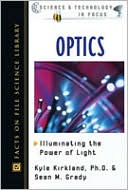

 |

|

The average rating for Optics based on 2 reviews is 3.5 stars.
Review # 1 was written on 2012-09-06 00:00:00 Bernard Goodno Bernard GoodnoSusskind's writing style is excellent. The information is always there when you need it. The superb clarity and minimalism of his writing helps understanding very much. You can tell he's a great professor. This is not a book for beginners (obviously) and includes a lot of the mathematical formulation of the theory. On the other hand, many of the formulae are included mostly to provide a visual support for what's expressed in words (like taking a look at the terms to get a feeling of what the formula does). But since there are no deep derivations (you're expected to be, to an extent, already familiar with them) most of these formulae don't help you get to the next level of understanding, not really. Still they're nice to have on the page. There are also lots of excellent diagrams. Overall, the book is addressed to a physicist with a strong background in theoretical physics (at an absolute minimum general relativity and semiclassical field theory) or to an amateur who understands theoretical physics very well at the conceptual level and is willing to skip the math and take Susskind's word for it. It's enjoyable, it's well presented, and Susskind has the sort of writing voice many fiction writers would kill for. He's engaging, and his passion and unquenched curiosity for the subject seeps out. |
Review # 2 was written on 2014-08-08 00:00:00 Petra Hartmann Petra HartmannLeonard Susskind is definitely the best alive physicist. I've recently learned about him that he was the man who treated Veneziano's dual model as quantum mechanical oscillating string. This book is very hard to comprehend. All the topics are so abstract that you can merely imagine what is going on. Starting with simple Schwarzchild metric and doing manipulations in a way that you get conformally flat Minkowski space-time and then transform it to Rindler space is like whatever. Penrose diagrams are fatality. On the other hands, authors get through different topics cohesively. I have no degree in physics, but I was able to follow majority of logic flow. The main aim of this book is explore black holes and show that they can be represented as a very very big 1 dimensional string Black holes are extremely rare objects to observe in reality. However, they are just solutions to Einstein equations and physicist love to do so (solve those non-linear differential equations in arbitrary space-times in D dimension - whatever 2). If there exists a black hole then you can do some theoretical experiments. You can either stand far away from horizon or fall into a black hole. That is the main observation in the book that discussions go around. Some fundamental laws should have to be modified that our current understanding of black holes be more realistic (and reasonable). This book discusses 4 different views: Black Hole Complimentary, UV/IR connection, Holographic principle and String view of Black Holes. There are some mathematical formulas around to prove assumptions. At the end, you see that there exists a pattern: You have to find a connection between Bekenstein-Hawking entropy formula and statistical microscopic states or thermodynamic entropy. Authors claim that calculations on all types of black holes that were studied precisely agree with Bekenstein-Hawking entropy formula. |
CAN'T FIND WHAT YOU'RE LOOKING FOR? CLICK HERE!!!